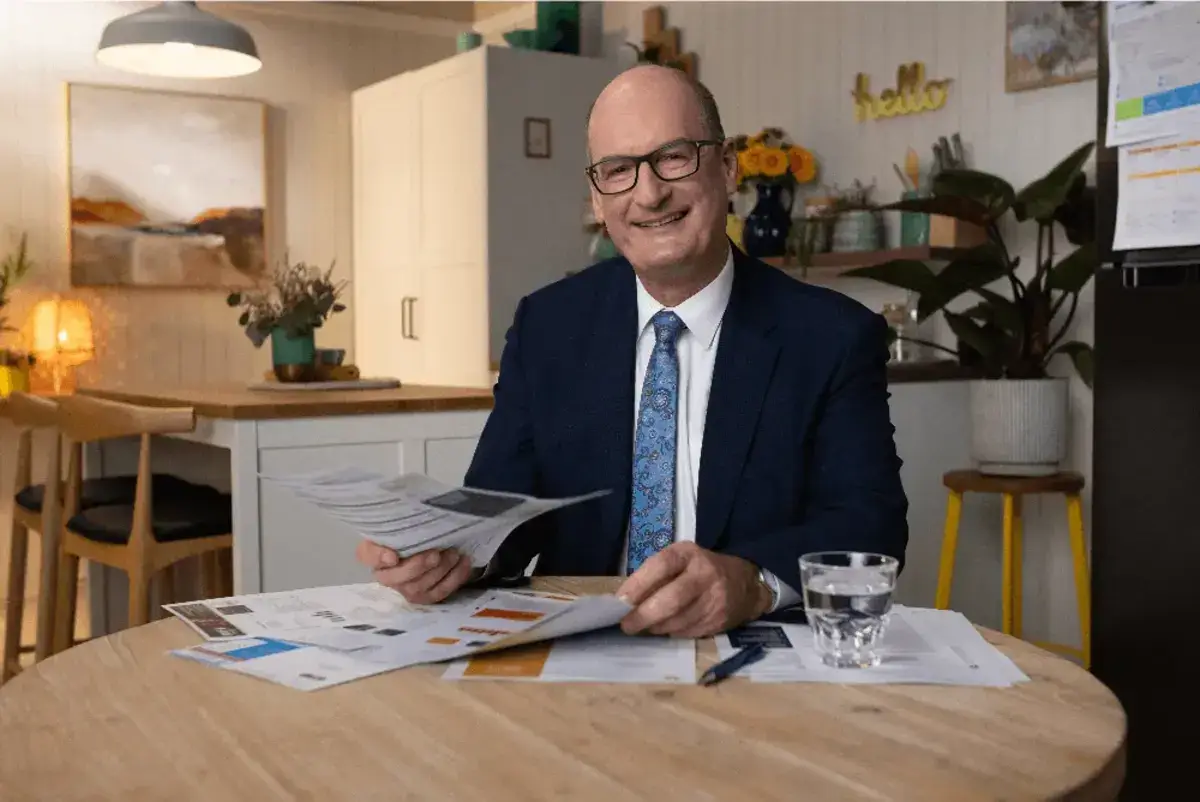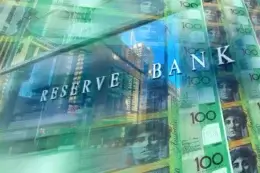
The following is David Koch’s personal views, as published in his ‘Your Money Digest’ newsletter.
Hi everyone,
Hope you’ve had a good week. Libby and I returned last night from Portugal after a couple of days break following an exceptional five days hanging out with Virgin’s Sir Richard Branson. A chance to find out what makes this extraordinary entrepreneur tick.
For those who want a detailed sense of what makes Branson a great entrepreneur, I’ll follow up in a week or so with a podcast on my full two-hour sit-down interview with him.
I’ve met and interviewed Richard a number of times over the years, but always in very short bursts for Sunrise. I have always wanted to get to know him and understand what makes him so successful. Let me tell you, he didn’t disappoint.
I’m grateful for the extraordinary access and for what I learned from him. We cruised out of Athens for a couple of days on Virgin Voyages and then flew to Majorca for a few days at his newest luxury boutique hotel… it was quite the experience and has me asking why I didn’t retire from Sunrise earlier.
The latest economic figures are out
But galivanting around Europe hasn’t stopped me following what has been going on at home, particularly when it’s a Reserve Bank Board meeting week and the latest economic growth figures are out.
As expected, in Governor Philip Lowe’s final RBA Board meeting, official interest rates were kept on hold for a third consecutive month… much to the relief of borrowers who have endured the shortest, sharpest jump in repayments in a generation.
And by the look of the economic growth figures (0.4 per cent for the June quarter and 2.4 per cent for the year) and the dramatic fall in household consumption, the economy looks to be slowing very quickly.
The outgoing RBA Governor’s statement remained largely unchanged after Tuesday’s meeting. The Board retained its policy tightening bias, with the final paragraph repeating, “Some further tightening of monetary policy may be required to ensure that inflation returns to target in a reasonable timeframe, but that will continue to depend upon the data and the evolving assessment of risks.”
All eyes are now on incoming Governor Michele Bullock and whether she will raise rates again in this cycle. In a speech last week, she said the central bank “may still need to raise rates again” and that’s because the RBA still has concerns about costs for services, as well as rising rental, wages and energy costs.
It says that “inflation in Australia has passed its peak and the monthly CPI indicator for July showed a further decline… inflation is still too high and will remain so for some time yet.”
But “significant uncertainties” about the economic outlook could mean that 4.1 per cent is the peak cash rate for this cycle. The statement referred to uncertainties around the “outlook for household consumption”, the “outlook for the Chinese economy”, and that the “unemployment rate is expected to rise gradually.”
So the third quarter Consumer Price Index (CPI), released on 25 October, is going to be absolutely critical in determining the future of rates. Money markets are now pricing in a 30 per cent chance of another rate hike by year end.
Consumer spending crashes
No wonder the RBA Board meeting expressed concerns about household consumption.
The Australian Bureau of Statistic’s monthly household spending indicator implies, at face value, a more than 2 per cent quarterly DECLINE in the June quarter in nominal consumption covered by the indicator (~64% of consumer spending).
When you adjust for inflation, it is a big fall in real terms.

Source: RBA
The reality is… it looks and feels like we’re in an economic recession
Consumers have gone so deep into the bunker and reigned in their spending so much that we are all but in a recession, except by name.
Don’t be fooled by the latest economic growth figures for the March to June quarter. Yes, it’s looking in the rear-view mirror a fair way back, but that’s just the way it is.
According to the data, the economy grew 0.4 per cent in the quarter (after an upwardly revised 0.4 per cent lift in the March quarter) for annual growth of 3.4 per cent. Looks good as it is well above the decade average of around 2.4 per cent.
However, the economic growth figures (officially called the national accounts) were driven by our massive trade surpluses, as exporters continue to excel, and also strong investment figures.
Look behind those rosy figures and a different picture is emerging. Productivity is down sharply by 3.6 per cent for the year. The result was driven by solid exports and investment.
And Australian households are tightening their spending belts and have almost used up all the savings they built during lockdowns. Household spending in the national accounts figures was up only 0.1 per cent for the quarter, and savings ratios are at a 15-year low – that’s how much higher interest rates are hurting.
While, on the surface, quarter economic growth looks solid, remember we have a massive immigration program underway. In fact, population growth added 0.7 per cent to the economic growth figures. That’s a huge impact and one we haven’t seen since 1974.
Take the impact of population growth out of the figures and, on a like-for-like basis, the economy contracted by 0.3 per cent; the second quarterly contraction in a row if you take out the population growth stimulus.
The definition of an economic recession is two consecutive quarters of negative economic growth. That’s why even though the economic growth figures look good they don’t feel good to average Australians.

Source: ABS
Even though interest rates are on hold… there are still plenty of better deals on offer
While it’s a relief there was not another rate increase, the previous rate rises are having a significant impact on average Australians. In such tight conditions, people are hiding their wallets, and reining in spending wherever they can. We are finally starting to see that behaviour is having an effect on overall prices.
Australians with a $750,000 mortgage on a variable rate could already be paying $1,814 more each month than they were at the start of May 2022.

Source: Compare the Market. Notes: Reserve Bank Lenders’ Interest Rates. Monthly repayments do not include any reduction in the mortgage balance over time. These calculations assume: An owner-occupied variable interest rate of 2.86% pa in May 2022; principal and interest (P&I) repayments; cash rate increases are passed on in full; the loan term is 30 years; and there are no monthly fees.
But, as I constantly say, you don’t have to sit there and accept rising rates. Do some research, compare different loans, and see what you could be saving. Depending on your circumstances, the difference could save you thousands over the life of your loan.
Once you’re armed with some information, phone your lender and see if they can offer a discount. If the answer is no, be prepared to walk.
Compare the Market analysis shows the difference between some of the advertised rates is as much as 0.65 per cent. A person with an owner-occupier $750,000 loan could save $314 a month when they switch from a rate of 6.34 per cent to 5.69 per cent.

Source: Compare the Market. Notes: Monthly repayments do not include any reduction in the mortgage balance over time. These calculations assume: An owner-occupied variable interest rate of 5.69% compared to 6.344% pa; principal and interest (P&I) repayments; the loan term is 30 years; and there are no monthly fees.
With insurances and energy prices still on the rise, these are also important targets for families searching for savings.
Dig into the CPI figures and you’ll find the major culprits. Electricity is up 15.7 per cent, gas is up 13.9 per cent and insurance and financial services are up 8.5 per cent. These are the bills you need to put on your budgeting hit list.
The best part is, these are some of the easiest expenses to compare and switch and we know the savings can be big.
Higher oil prices are about to hit hard
Tough times ahead for drivers, but investors in oil stocks are set for quite a ride. That’s because oil prices are now up 30 per cent in two months and back up to their highest levels since November 2022.
Last time oil prices were this high, the US Strategic Petroleum Reserve (SPR) had 240 million MORE barrels. This time the SPR remains near its lowest levels since the 1980s.
And oil prices are now 22 per cent above the $US67-$72 a barrel range, where the US wants to refill the reserves.
Let me explain why higher oil prices are back. First, the cartel of the world’s biggest producers, OPEC, is cutting production. Less supply means demand will push prices up.
Aussie home values continue to defy gravity
While I was travelling in Europe, there was a lot of discussions in the finance media about the housing bubble in Canada. That values are so inflated their housing market is expected to crash… in the same way the UK property market has dropped significantly.
Canada is part of the G7, so I was interested in this chart from IFM Investors which lays Australian housing values over what has happened in G7 countries.
America is one of the biggest users of oil. Since the OPEC oil crisis of the 1970s, it has kept hundreds of millions of barrels of oil literally in underground storage caves to protect its economy against being held hostage by OPEC.
Whenever global oil prices get too high the US uses some of their strategic reserves to push up supply and bring prices down. When prices are down, the US will then top up their reserves.
The issue now is that OPEC has cut production and pushed up prices, but the US strategic reserve is so slow they can’t dump their own supply onto the market to bring prices back down this time.
That’s why high oil prices are here to stay… which will feed into our inflation figure.

Source: @KobeissiLetter / X
Aussie home values continue to defy gravity
While I was travelling in Europe, there was a lot of discussions in the finance media about the housing bubble in Canada. That values are so inflated their housing market is expected to crash… in the same way the UK property market has dropped significantly.
Canada is part of the G7, so I was interested in this chart from IFM Investors which lays Australian housing values over what has happened in G7 countries.

Source: IFM Investors
As you can see, Australian house prices have massively outperformed the rest of the world. Real house prices (taking into account inflation) have quadrupled since the start of this century – and our values seem to be holding up as we go into the spring selling season.
What the latest profit reporting season tells us about Australian listed companies
Yet another fast and furious profit reporting season is over. We get bombarded with so much information that it’s pretty hard to get perspective on what actually happened.
That’s why I always look forward to CommSec’s wrap up of reporting season to provide the overview. CommSec’s key takeaways from this year were:
• Aggregate revenue rose 8.9 per cent over the last financial year, but expenses were up by 13.9 per cent… so net statutory profit fell by 42.9 per cent. Profits rose for 40 per cent of companies and fell for 60 per cent. While 84 per cent of companies issued a profit,16 per cent recorded a statutory loss.
• Earnings per share fell by 27.7 per cent, dividends fell by 2.5 per cent and cash balances were cut by 9.7 per cent.
• An historically high proportion of companies issued a dividend or announced/extended a share buyback. The large number of buybacks also suggests that companies are more optimistic about future Australian household spending, despite deep consumer pessimism and rapid rate hikes. Qantas was one company that opted to extend a buyback rather than issue a dividend.
• According to FN Arena, 31.5 per cent of the 295 biggest listed companies beat market forecasts; 39.3 per cent had results in line with forecasts; and 29.2 per cent missed or fell short of analyst expectations.
Two words dominated the company profit reporting season: ‘challenging’ and ‘resilient’. It describes how companies, and the broader economy, have performed in the face of marked increases in interest rates, the rising cost of living, higher input costs and an uncertain global economy.
• Metal recycler, Sims, reflected on its ‘resilient’ performance, despite reporting a 70 per cent fall in profit and a 58 per cent cut in its final dividend. And Seven West Media reflected on its ‘solid’ financial results despite ‘the challenging environment’.
• The performance of retailers – and consumer-focused companies more generally –can so far be put under the column of ‘resilient’. Carsales.com celebrated its ‘fantastic’ set of results with profit quadrupling. Sneaker retailer Accent Group reported improving sales at the beginning of financial year 2024 trading, sending its share price up 17 per cent.
• In a sign of stabilisation in the Aussie housing market, conglomerate Wesfarmers reported solid growth in its hardware store chain Bunnings and lifted its annual profit, sending its shares over 3 per cent higher.
• Woolworths out-performed Coles. Coles is battling costs and left the final dividend unchanged. Woolworths outlined its strategy to deal with ‘shrinkage’ or theft, while lifting its final dividend. But challenges are ahead of both as consumer spending patterns change.
• Many retailers reported weaker conditions over the six months to June, and particularly soft July results. An exception being online furniture retailer, Temple & Webster, noting a pick-up in sales over the second half of the financial year with momentum continuing into August.
There were a surprising number of companies that have expressed confidence in the future.
• Even JB Hi-Fi, in categorising ‘heightened uncertainty’, plans to use all the tools in the kit bag in the period ahead to drive sales, including data mining, targeted marketing, inventory control and cost reductions. Bapcor and Carsales.com remain upbeat. GUD said there has been no sign of motorists delaying vehicle repairs.
• Medical imaging firm, Pro Medicus noted a solid outlook with trends driving the industry continuing. And wealth management firm Netwealth flagged a strong sales pipeline. But SEEK warned about the threat of higher unemployment ahead. And Computershare is worried about more rate hikes ahead.
• The holy grail of any business is pricing. Solid results from James Hardie and Boral had much to do with their ability to pass on higher costs to builders and customers. GUD also highlighted the support of solid margins in its report. And Transurban noted that it was able to raise about 70 per cent of its tolls in line with higher inflation rates.


The travel bug is an expensive one
So, it seems we’ve changed the way we pay for travel to cope with the cost.
A recent Compare the Market survey found 40.4 per cent of adult Australians don’t pay for their holidays upfront.
Although more than half of people (59 per cent) like to save all their money and pay for holidays in full at the time of booking, 14.6 per cent say they use a credit card, 12.2 per cent pay in instalments and 4.4 per cent use ‘Buy Now, Pay Later’ services.

Source: Compare the Market
Here are six holiday budget tips to ease the financial pain of travel.
Look for cheap airfares and accommodation
Sites like Skyscanner can help find cheap flights and allow you to see what dates might even be cheapest. While you might find cheap flights, your search shouldn’t end there. Look for affordable accommodation too. If you’re going to be out exploring all the time, do you really need that ocean view?
Monitor exchange rates
If you’re travelling overseas, do your research and shop around for the best exchange rates online. As a rule of thumb, never purchase your international currency at the airport, where exchange rates are notoriously bad. It might not seem like much, but the difference between getting 1.3 or 1.4 $US to $A can mean an extra $50-$80 in your pocket when you’re spending $2000.
Search for value add-ons or deals
Look for hotel inclusions like breakfast – this can save you a lot of time and money on your holiday. If it’s a buffet-style breakfast, maybe you can take a few croissants in a napkin for a snack later on. Other add-ons to look for are free parking and kids staying and eating for free. Depending on how long you’re staying at a place, this can save you a lot of money.
Avoid the tourist tax
Get off the beaten track. Follow the locals to find the best restaurants and shops that don’t have a tourist tax attached to the price list. For example, the waterfront in Venice can often be double the price because that’s where all the tourists are and its the hub for water taxis. If you go off the beaten track, there are a cluster of pizzerias and wonderful stores that aren’t as expensive.
Stay local
Ditch the long-haul airfare and enjoy an interstate holiday in Australia. There are plenty of incredible destinations to explore in our own backyard. Whether it be the crisp, white sandy beaches in the Whitsundays or the dusty red outback near Uluru, you can find lots to do.
Compare travel insurance
Travel insurance is one thing that should never be overlooked when planning a holiday. If your flight gets cancelled, luggage gets stolen, or you have a medical emergency – you’re going to wish you were covered. Compare the Market can help sightseers look for travel insurance that’s suited to their needs, circumstances and budgets.







